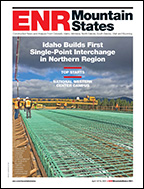One of the tallest bridges in the U.S. is about to receive an extensive seismic upgrade, including 2.2 million lb of structural steel. Bids open on Sept. 7 for a $71-million seismic retrofit for the 1970s-era Foresthill Bridge in Auburn, Calif. At 730 ft tall and 2,428 ft long, its retrofit will pose dizzying challenges to the selected contractor.

“We are garnering a lot of interest from contractors,” says Ken Grehm, director of public works for owner Placer County. Grehm has led more than 100 contractors on pre-bid tours of the site. Companies that have expressed interest include an American Bridge and Fluor Corp. joint venture, California Engineering, Golden Gate Bridge Inc., Skanska USA, Teichert Readymix and William P. Young Construction.
Tokyo-based Kawasaki Heavy Industries Ltd. fabricated the new steel- deck truss bridge for $13 million. It will replace a bridge that had originally faced demolition to make way for a dam. Although seismic concerns halted the Bureau of Reclamation’s construction on the Auburn Dam, the bridge remains a vital link for the small town of Foresthill.
Sacramento-based Quincy Engineering Inc. designed a $41-million solution to meet seismic standards set after 1989’s Loma Prieta earthquake, which measured 6.9 on the Richter scale. The 2.2 million lb of structural steel includes restrained braces at the ends to absorb energy. “This was chosen because of the lower cost and lower maintenance compared to hydraulic dampers,” says John Quincy, Quincy engineering principal engineer. New plates will be bolted on the ends of the lower chords where they meet the abutment.
The contractor will start by building a $5-million catwalk to access the structure. The catwalk will be left in place when construction ends to allow access for inspectors.
Careful staging will be required to replace the gusset plates. A wind alarm will notify workers if wind speeds exceed 60 mph so that braces quickly can be reattached.
To ease traffic during construction and stabilize the bridge, a 15-ft gap between the two lanes will be filled in. The bridge was originally designed to handle the load of a center section; holes were pre-drilled into the transverse member of the truss to attach the concrete deck system, but the traffic at the time didn’t warrant spending the money, Quincy says.
The bid also calls for a $25-million sandblasting and repainting of the entire iconic green structure. Because the original paint contains lead and cadmium, the materials will have to be contained using tarps and disposed of properly, not dropping into the American River below.
Foresthill Bridge is one of 1,236 locally controled bridges that the California Dept. of Transportation has determined are in need of seismic retrofitting, at a total estimated cost of $2 billion. So far, 733 bridges have been retrofitted.

